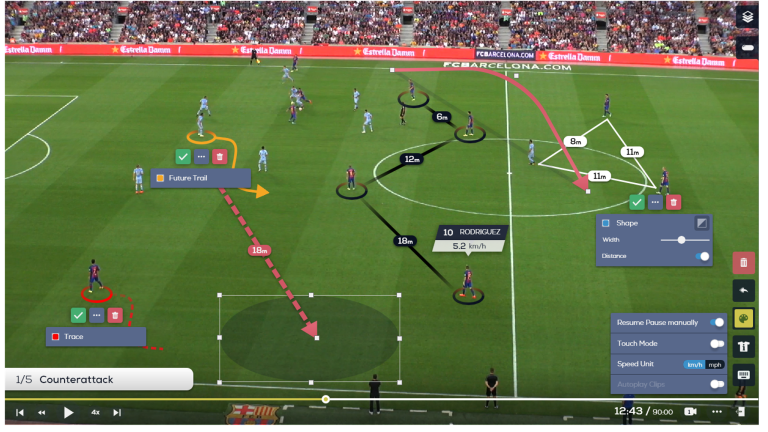Football, often celebrated as “the beautiful game,” is much more than just athleticism, skill, and strategy on the pitch. Behind every goal, tackle, and victory lies an increasingly important element that is transforming how the sport is understood, coached, and played: football analytics. In recent years, the use of data in football has evolved from a minor consideration to a central aspect of how teams prepare for matches, how managers make decisions, and how clubs build winning squads. In today’s digital age, Socolive TV not only provides live match streaming but also offers insights into the metrics that define success in modern football. As football continues to embrace the power of analytics, it becomes clear that data is now one of the key factors behind every victory on the pitch.
The Rise of Football Analytics
The concept of football analytics is not entirely new. Clubs and managers have long used basic statistics—such as goals, assists, and possession percentages—to make tactical decisions. However, the real revolution in football analytics began in the early 2000s with the advent of more sophisticated data tracking systems, such as Opta and Prozone, which introduced an unprecedented level of detail to match analysis.
What started as an attempt to quantify individual player performances has since grown into a complex and powerful field. Now, every match generates vast amounts of data on everything from player movements and passes to defensive pressures and shots on target. Advanced algorithms, machine learning, and AI tools are used to analyze this data, providing clubs and analysts with actionable insights that were once unimaginable.
The impact of analytics is now felt at every level of the game—from scouting and recruitment to in-match tactics and post-game analysis. Clubs that harness the power of data are able to gain a significant advantage over those that rely solely on traditional methods.
How Football Analytics Works
Football analytics relies on a wide array of metrics and data points, many of which go far beyond the standard statistics traditionally seen in match reports. Here are some of the key areas where analytics plays a crucial role in modern football:
1. Player Performance Metrics
Player performance is at the heart of football analytics. In the past, a player might have been judged primarily by their goals, assists, or tackles, but today’s data offers a much more nuanced understanding of individual contributions. Here are some examples of performance metrics used in modern football analysis:
- Expected Goals (xG): Expected goals measure the quality of chances created and how likely a given shot is to result in a goal. By using historical data on thousands of similar shots, analysts can assign a probability to each chance, helping teams evaluate whether they are creating high-quality opportunities or simply taking speculative shots.
- Passing Networks: Football analytics also examines how teams move the ball through passing sequences. Data on individual player passing patterns helps analysts identify key players in ball distribution, assess how teams build attacks, and understand how effectively a side retains possession.
- Pressing and Defensive Actions: Defensive data, such as the number of pressures applied by a player, interceptions made, and recoveries of possession, help teams measure the effectiveness of their defensive strategies. Clubs are increasingly interested in how players contribute when their team is out of possession, particularly in high-pressing systems.
- Distance Covered and Heat Maps: Fitness and movement are crucial aspects of modern football. Using tracking data, teams can now measure the distance covered by each player, as well as their sprinting patterns and overall positioning on the pitch. Heat maps provide visual representations of where a player spends most of their time, offering insight into tactical roles and positioning.

2. Team Tactics and Strategy
Beyond individual player analysis, football analytics is also crucial in understanding and optimizing team tactics. Analytics tools allow managers to assess how their team is performing in key areas, such as ball retention, chance creation, and defensive solidity.
- Possession and Tempo: Teams are increasingly using data to fine-tune their approach to possession and ball movement. By analyzing metrics like average possession time, number of passes per possession, and passing speed, coaches can identify whether their team is controlling the tempo of the game or playing too cautiously.
- Attacking Efficiency: Analytics can measure how efficiently a team transitions from defense to attack. Metrics like “progressive passes” and “final third entries” provide insight into how well a team moves the ball up the field and creates scoring opportunities.
- Set Pieces: Set pieces, such as free kicks and corners, are often overlooked aspects of the game, but they are a significant source of goals. Analytics on set-piece success rates, player positioning, and delivery accuracy allow teams to optimize their strategies in these crucial moments.
3. Scouting and Recruitment
One of the most impactful uses of football analytics is in player recruitment. Data-driven scouting allows clubs to identify talent that may not be immediately obvious through traditional scouting methods. Clubs like Liverpool and Manchester City have successfully leveraged analytics to make informed transfer decisions, signing players who fit their system and contribute in crucial statistical areas.
- Player Profiles: Using data from leagues around the world, clubs can build detailed statistical profiles of potential transfer targets. By comparing players’ performance in key metrics—such as ball progression, chance creation, or defensive actions—scouting departments can identify players who are most likely to succeed in their tactical systems.
- Market Value Prediction: Football analytics also plays a role in assessing a player’s market value and future potential. By analyzing age, performance trajectory, and injury history, clubs can make data-driven decisions about whether to invest in a player or avoid overpaying for short-term success.
The Impact of Football Analytics on Match Outcomes
The use of football analytics is increasingly being linked to success on the pitch. Teams that integrate data-driven strategies into their planning and decision-making processes often have a competitive edge over their rivals. By using data to inform tactical decisions, manage player workload, and improve recruitment strategies, clubs can optimize their performance and increase their chances of victory.
1. Tactics Informed by Data
In modern football, tactics are frequently shaped by data. Coaches use analytics to fine-tune their strategies before matches, identifying the weaknesses of their opponents and exploiting them during the game. For instance, data might reveal that a certain team is vulnerable to quick counter-attacks or struggles to defend set-pieces. By analyzing these insights, managers can adjust their game plans accordingly, giving their team the best chance of success.

2. In-Game Adjustments
Football analytics also plays a crucial role during matches. Many clubs now have analysts working alongside the coaching staff in real-time, providing instant feedback on the team’s performance. By tracking key data points—such as possession, pressing success, or defensive positioning—coaches can make informed decisions about substitutions, tactical changes, or adjustments to their formation.
3. Post-Match Analysis and Player Development
After every match, data is used to conduct a thorough post-mortem of the team’s performance. By analyzing player performance metrics and team statistics, coaches can identify areas for improvement and help players understand their strengths and weaknesses. Over time, this data-driven approach contributes to player development, helping athletes reach their full potential.
Conclusion
Football analytics has undeniably become a crucial part of the modern game. The numbers behind every victory provide invaluable insights into player performance, team tactics, and recruitment strategies, allowing clubs to gain a competitive edge. As the field of football analytics continues to evolve, it will undoubtedly play an even greater role in shaping the future of football, from grassroots development to the highest levels of the professional game.
For football fans eager to see the latest insights and analysis, Socolive TV is the perfect platform to stay connected with live match streaming. And for those seeking the excitement of the game, Trực tiếp bóng đá Socolive make it easier than ever to watch live football matches and track the numbers behind every victory.
